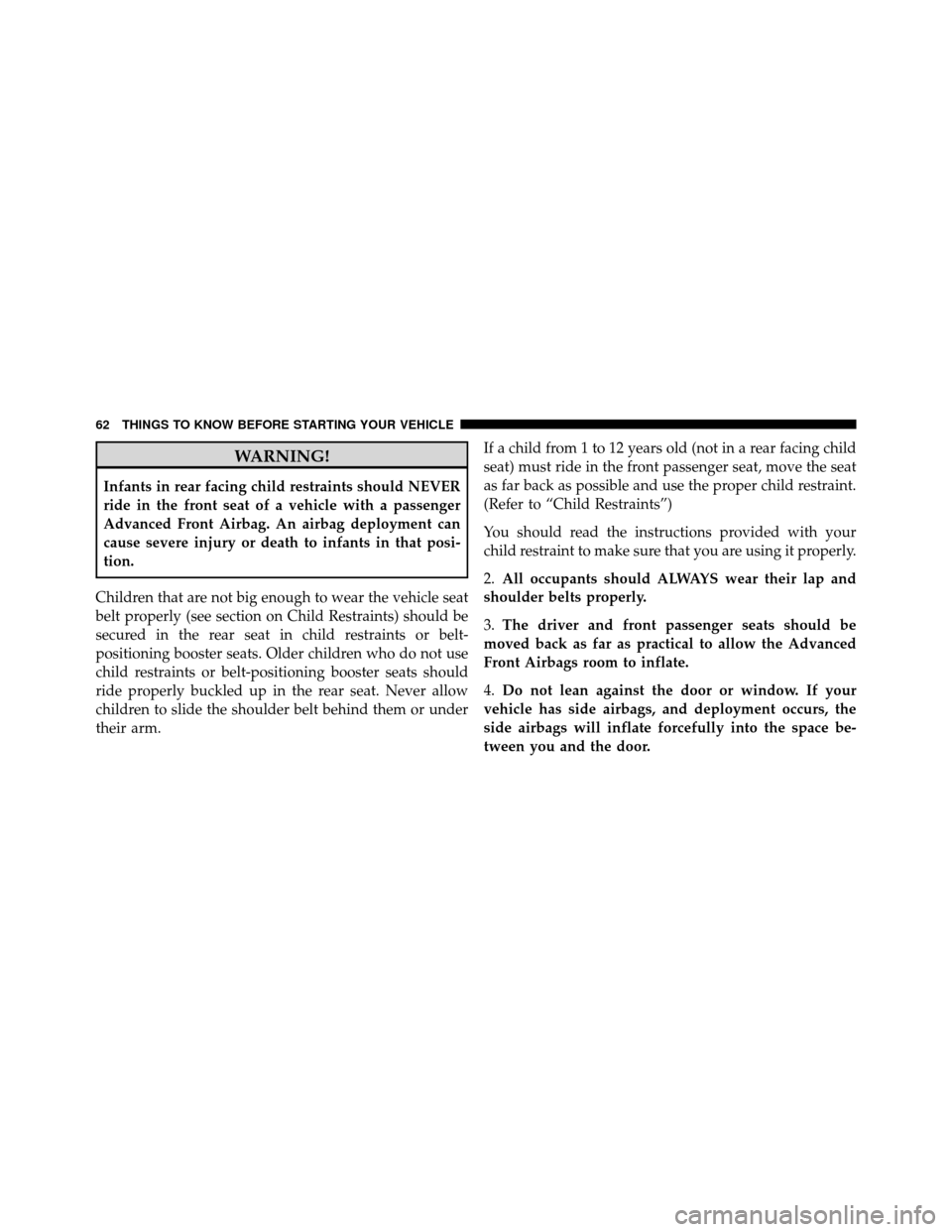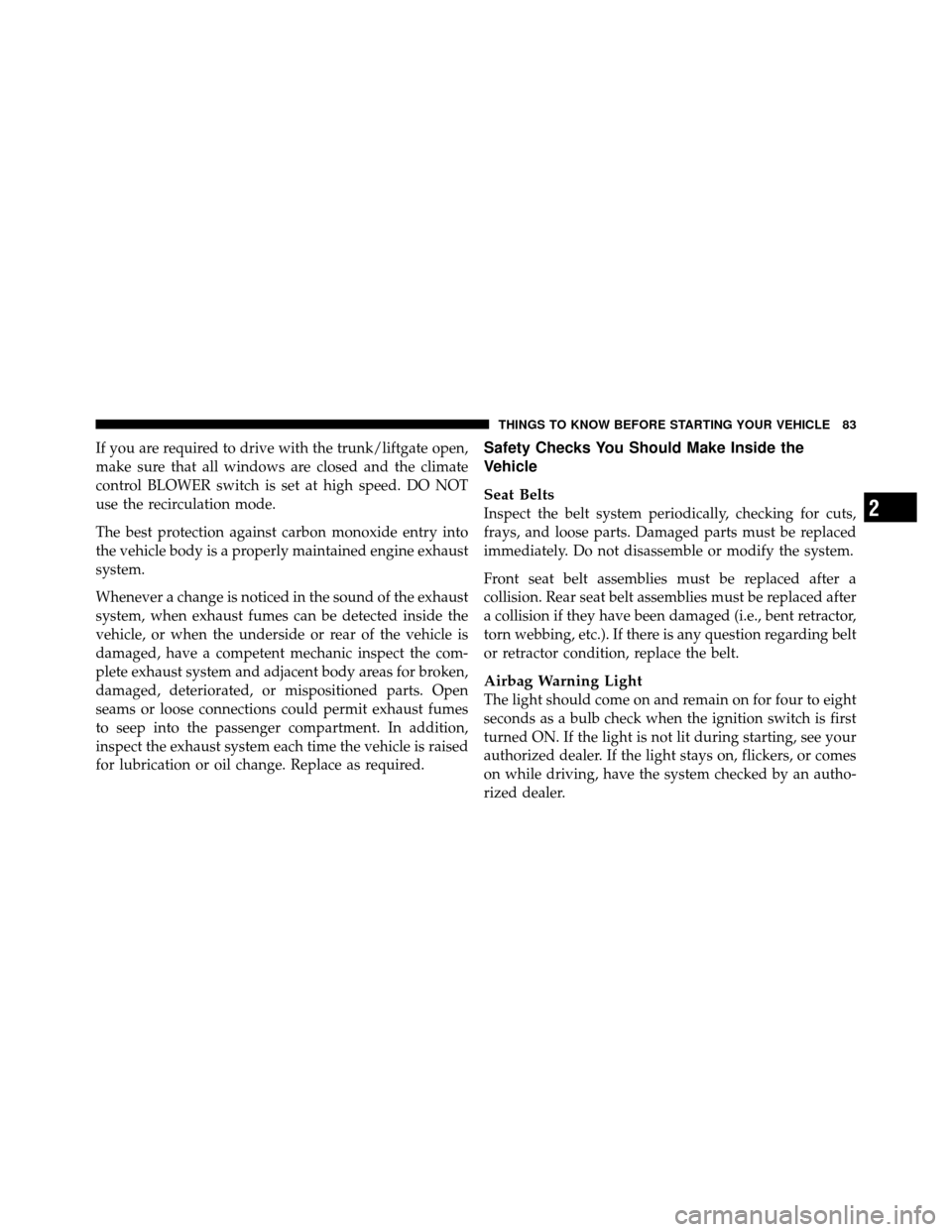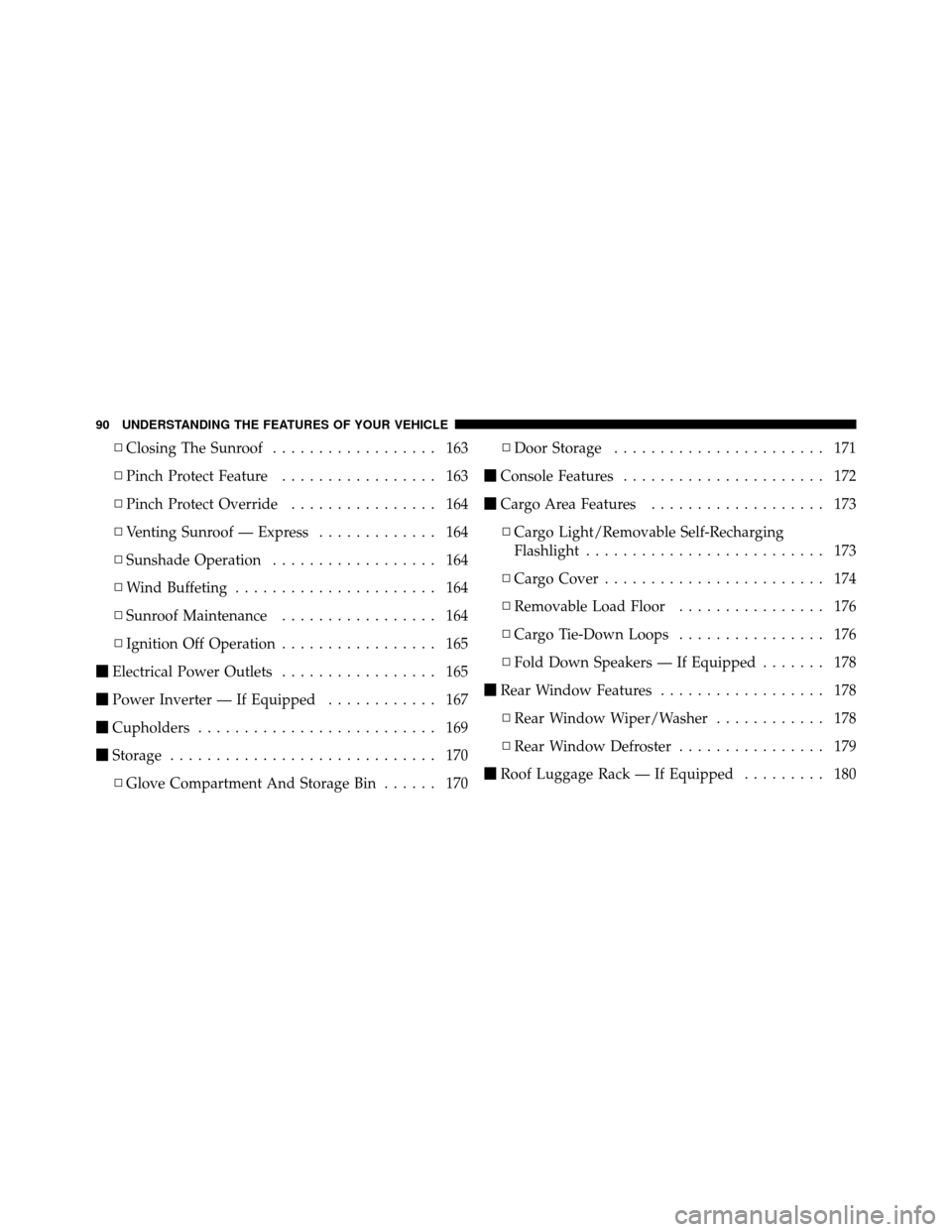Page 58 of 496

This vehicle may be equipped with driver and/or front
passenger seat track position sensors that may adjust the
inflation rate of the Advanced Front Airbags based upon
seat position.
This vehicle may be equipped with a driver and/or front
passenger seat belt buckle switch that detects whether
the driver or front passenger seat belt is fastened. The
seat belt buckle switch may adjust the inflation rate of the
Advanced Front Airbags.
This vehicle is equipped with Supplemental Side Airbag
Inflatable Curtains (SABIC) to protect the driver, front,
and rear passengers sitting next to a window. The SABIC
are located above the side windows. The trim covering
the side airbags is labeled SRS AIRBAG.
NOTE:
•Airbag covers may not be obvious in the interior trim;
but they will open during airbag deployment.
•After any collision, the vehicle should be taken to an
authorized dealer immediately.
Airbag System Components
Your vehicle may be equipped with the following airbag
system components:
•Occupant Restraint Controller (ORC)
•Airbag Warning Light
•Steering Wheel and Column
•Instrument Panel
•Knee Impact Bolster
•Driver Advanced Front Airbag
•Passenger Advanced Front Airbag
•Supplemental Seat-Mounted Side Airbags (SAB)
•Supplemental Side Airbag Inflatable Curtains (SABIC)
2
THINGS TO KNOW BEFORE STARTING YOUR VEHICLE 57
Page 61 of 496
Supplemental Side Airbag Inflatable Curtain
(SABIC)
SABIC airbags may offer side-impact and vehicle rollover
protection to front and rear seat outboard occupants in
addition to that provided by the body structure. Each
airbag features inflated chambers placed adjacent to the
head of each outboard occupant that reduce the potential
for side-impact head injuries. The SABIC airbags deploy
downward, covering both windows on the impact side.NOTE:
•Should a vehicle rollover occur, the pretensioners
and/or SABIC curtains on both sides of the vehicle
may deploy.
•Airbag covers may not be obvious in the interior trim;
but they will open during airbag deployment.
Side Curtain Airbag Label Location
60 THINGS TO KNOW BEFORE STARTING YOUR VEHICLE
Page 63 of 496

WARNING!
Infants in rear facing child restraints should NEVER
ride in the front seat of a vehicle with a passenger
Advanced Front Airbag. An airbag deployment can
cause severe injury or death to infants in that posi-
tion.
Children that are not big enough to wear the vehicle seat
belt properly (see section on Child Restraints) should be
secured in the rear seat in child restraints or belt-
positioning booster seats. Older children who do not use
child restraints or belt-positioning booster seats should
ride properly buckled up in the rear seat. Never allow
children to slide the shoulder belt behind them or under
their arm. If a child from 1 to 12 years old (not in a rear facing child
seat) must ride in the front passenger seat, move the seat
as far back as possible and use the proper child restraint.
(Refer to “Child Restraints”)
You should read the instructions provided with your
child restraint to make sure that you are using it properly.
2.
All occupants should ALWAYS wear their lap and
shoulder belts properly.
3. The driver and front passenger seats should be
moved back as far as practical to allow the Advanced
Front Airbags room to inflate.
4. Do not lean against the door or window. If your
vehicle has side airbags, and deployment occurs, the
side airbags will inflate forcefully into the space be-
tween you and the door.
62 THINGS TO KNOW BEFORE STARTING YOUR VEHICLE
Page 64 of 496
5.If the airbag system in this vehicle needs to be
modified to accommodate a disabled person, contact
the Customer Center. Phone numbers are provided
under �If You Need Assistance�.
WARNING!
•Relying on the airbags alone could lead to more
severe injuries in a collision. The airbags work
with your seat belt to restrain you properly. In
some collisions, the airbags won’t deploy at all.
Always wear your seat belts even though you have
airbags.
(Continued)
WARNING! (Continued)
•Being too close to the steering wheel or instrument
panel during Advanced Front Airbag deployment
could cause serious injury, including death. Air-
bags need room to inflate. Sit back, comfortably
extending your arms to reach the steering wheel or
instrument panel.
•Side airbags also need room to inflate. Do not lean
against the door or window. Sit upright in the
center of the seat.
2
THINGS TO KNOW BEFORE STARTING YOUR VEHICLE 63
Page 68 of 496

type of collision. In these events, the ORC will deploy the
SABIC only on the impact side of the vehicle.
A quantity of non-toxic gas is generated to inflate the side
curtain airbag. The inflating side curtain airbag pushes
the outside edge of the headliner out of the way and
covers the window. The airbag inflates in about 30 ms
(about one-quarter of the time that it takes to blink your
eyes) with enough force to injure you if you are not belted
and seated properly, or if items are positioned in the area
where the side curtain airbag inflates. This especially
applies to children. The side curtain airbag is only about
3-1/2 in (9 cm) thick when it is inflated.
Because airbag sensors estimate deceleration over time,
vehicle speed and damage are not good indicators of
whether or not an airbag should have deployed.
NOTE:In a rollover the pretensioners and/or SABIC
airbags may deploy on both sides of the vehicle.Front and Side Impact Sensors
In front and side impacts, impact sensors can aid the
ORC in determining appropriate response to impact
events. Additional sensors in the ORC determine the
level of airbag deployment and provide verification.
Enhanced Accident Response System
In the event of an impact causing airbag deployment, if
the communication network remains intact, and the
power remains intact, depending on the nature of the
event the ORC will determine whether to have the
Enhanced Accident Response System perform the follow-
ing functions:
•Cut off fuel to the engine.
•Flash hazard lights as long as the battery has power or
until the ignition key is turned off.
2
THINGS TO KNOW BEFORE STARTING YOUR VEHICLE 67
Page 84 of 496

If you are required to drive with the trunk/liftgate open,
make sure that all windows are closed and the climate
control BLOWER switch is set at high speed. DO NOT
use the recirculation mode.
The best protection against carbon monoxide entry into
the vehicle body is a properly maintained engine exhaust
system.
Whenever a change is noticed in the sound of the exhaust
system, when exhaust fumes can be detected inside the
vehicle, or when the underside or rear of the vehicle is
damaged, have a competent mechanic inspect the com-
plete exhaust system and adjacent body areas for broken,
damaged, deteriorated, or mispositioned parts. Open
seams or loose connections could permit exhaust fumes
to seep into the passenger compartment. In addition,
inspect the exhaust system each time the vehicle is raised
for lubrication or oil change. Replace as required.Safety Checks You Should Make Inside the
Vehicle
Seat Belts
Inspect the belt system periodically, checking for cuts,
frays, and loose parts. Damaged parts must be replaced
immediately. Do not disassemble or modify the system.
Front seat belt assemblies must be replaced after a
collision. Rear seat belt assemblies must be replaced after
a collision if they have been damaged (i.e., bent retractor,
torn webbing, etc.). If there is any question regarding belt
or retractor condition, replace the belt.
Airbag Warning Light
The light should come on and remain on for four to eight
seconds as a bulb check when the ignition switch is first
turned ON. If the light is not lit during starting, see your
authorized dealer. If the light stays on, flickers, or comes
on while driving, have the system checked by an autho-
rized dealer.
2
THINGS TO KNOW BEFORE STARTING YOUR VEHICLE 83
Page 91 of 496

▫Closing The Sunroof .................. 163
▫ Pinch Protect Feature ................. 163
▫ Pinch Protect Override ................ 164
▫ Venting Sunroof — Express ............. 164
▫ Sunshade Operation .................. 164
▫ Wind Buffeting ...................... 164
▫ Sunroof Maintenance ................. 164
▫ Ignition Off Operation ................. 165
� Electrical Power Outlets ................. 165
� Power Inverter — If Equipped ............ 167
� Cupholders .......................... 169
� Storage ............................. 170
▫ Glove Compartment And Storage Bin ...... 170▫
Door Storage ....................... 171
� Console Features ...................... 172
� Cargo Area Features ................... 173
▫ Cargo Light/Removable Self-Recharging
Flashlight .......................... 173
▫ Cargo Cover ........................ 174
▫ Removable Load Floor ................ 176
▫ Cargo Tie-Down Loops ................ 176
▫ Fold Down Speakers — If Equipped ....... 178
� Rear Window Features .................. 178
▫ Rear Window Wiper/Washer ............ 178
▫ Rear Window Defroster ................ 179
� Roof Luggage Rack — If Equipped ......... 180
90 UNDERSTANDING THE FEATURES OF YOUR VEHICLE
Page 92 of 496
MIRRORS
Inside Day/Night Mirror
A two-point pivot system allows for horizontal and
vertical mirror adjustment. Adjust the mirror to center on
the view through the rear window.
Headlight glare can be reduced by moving the small
control under the mirror to the night position (toward the
rear of vehicle). The mirror should be adjusted while set
in the day position (toward the windshield).
Adjusting Rearview Mirror
3
UNDERSTANDING THE FEATURES OF YOUR VEHICLE 91